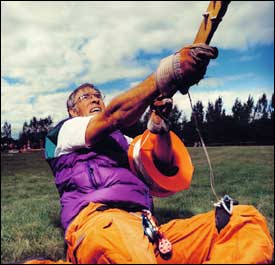AT EIGHT O’CLOCK on a summer morning, Richard Synergy parks his blue 1987 Dodge station wagon in a farmer’s wheat field a few miles outside the southern Ontario town of Kincardine and begins unloading a preposterous jumble of gear: sewing machine, rubber mallet, work gloves, electric drill, carabiners, bundles of fiberglass spars, and two gas-powered generators capable of putting out 6,600 watts. “Nice clean current,” he says with a tender pat. “Ripple-free.”
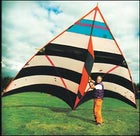
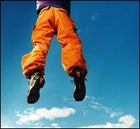
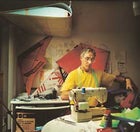
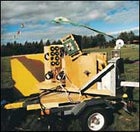
Synergy reaches into the well-scuffed interior of the car‹this time with a certain decorousness, as if helping a high-heeled starlet from the backseat—and retrieves the pink-and-black nylon skin of the Millibar Messenger, a 17-pound, single-string delta kite with a 30-foot wingspan, which he designed and built himself. “I’m as nervous as a pregnant nun,” he says. “Totally uptight and very mission-oriented.”
His mission? To send the Millibar Messenger higher than any other single-string kite in the history of flight. In service to this, Synergy has slept a fitful ten hours over the previous three nights and worked without dinner until 11:30 the previous evening fine-tuning his equipment. “There’s no time for meals in this operation,” he explains. Instead he’s subsisted on boxes of vanilla-flavored Resource Standard, a nutritional drink for invalids.
It seems to be doing the trick. Synergy looks far younger than his 63 years. Dressed in a purple T-shirt and baggy hiking shorts, his arms and shoulders tanned from years of outdoor carpentry, he moves with the ticking energy of a hyperactive camp counselor. He lifts a yellow plywood box the size of a large doghouse off the trailer behind the car to reveal his homemade winch, a Rube Goldberg contraption gaudy with voltage meters, circuit boards, and 25,000 feet of Kevlar line spooling through a labyrinth of pulleys. He swings the winch around to face downwind, hooks it up to one of the generators, and gives it a test whirl by tweaking a black knob marked “takeup.” “If the line breaks,” he says, watching the winch spin in place, “it’s a $3,000 mistake.”
There is a ground crew of sorts, 12 kite-flying friends and ham-radio operators who have come to help lift stuff and basically stare. If the line snaps, the guys with the ham radios will disperse to locate the errant kite by pointing their parabolic antennas at the flashlight-size radio beacon attached to its nose. The hammies are beginning to trickle in now, half of them retired duffers in shorts and baseball caps. They’re hoping for an electronic foxhunt. Back in 1991, they tracked one of Synergy’s runaway kites for three hours as it flapped more than 20 miles downwind. Another fugitive kite was never found, despite classified ads placed in newspapers within a 50-mile radius and the aid of a Toronto psychic, hired by Synergy, who claimed to “see” the kite lying by a fence in a farmer’s field. “Kincardine is surrounded by farms,” Synergy says, “so that didn’t help a whole lot.”
It takes about five hours of futzing, but by 1 p.m. the kite is ready. Synergy thrusts two Casio wristwatches equipped with altimeters into a neon-green nylon bag stuffed with protective plastic foam and tiny battery-powered lightbulbs (to keep the chips in the watches from freezing) and secures it to the kite’s underside. This is the all-important payload; there can be no way of knowing the altitude unless the Casios return to earth safely. After making a few last-minute adjustments and strategically arranging his crew to guide the kite during takeoff, Synergy flips the switch on the winch. It rumbles like a flat tire as it reels in line—.thunka-thunka-thunka—and within seconds the Millibar Messenger is fluttering at 1,000 feet. He quickly reverses the winch and begins paying out four feet of line a second. “C’mon, kite!” he shouts. “That’s it, baby! Take the line! Take it! Get up into some good air! Catch something!”
Synergy assumes his position beside the winch like a captain at the helm. He’ll stand here for the next nine hours, squinting into a Magic Markerblue sky.
TO SPEND TIME WITH Richard Synergy is to understand that his preoccupation with science exceeds garden-variety geekdom. Here is a man so enamored of science, so swept away by the old-fashioned romance of it all, that he actually changed his last name to Synergy from Accetta. He stutters when he talks about wind shear. He has addressed an American Kitefliers Association conference dressed as a woman—his way of dramatizing the principles of lift and drag.
In short, Synergy has an idiosyncratic streak that over the years has either derailed him or saved him, depending on your point of view. From 1956 to 1960 he served as a “mineman” in the U.S. Navy, learning a little bit about explosives and electronic circuitry. After the navy he attended Duquesne University in Pittsburgh where he was, by his own account, a brilliant physics student. However, he dropped out before getting his degree and moved to Canada in 1963 to hunt and fish. For the next 18 years he bummed around, doing everything from spending 120 days a year in a canoe as a summer-camp guide to working with emotionally troubled families at the Browndale Clinic, a residential treatment facility outside Toronto. In 1981, he landed a job as a lab technician researching fuel-cell technology at the University of Toronto. But by 1984, when the university scaled back funding on the research and Synergy lost his job, he’d soured on the tech world. Rather than look for another buttoned-down nine-to-five lab position, he left the straight life behind for a monkish existence devoted to the study of kites.
He explains his odd detour this way: Great scientific minds must nurture their genius away from the inhibiting, hidebound establishments that dole out tenure and government grants; to search for their breakthroughs, they must be free. Thus, by the early 1990s, Synergy had embarked on his solitary and penurious struggle to surpass the world kite-flying altitude record of 12,471 feet, which had stood unchallenged since it was set by Henry Helm Clayton and A. E. Sweetland at the Blue Hill Meteorological Observatory in Milton, Massachusetts, in 1896. He arranged his life around this pursuit, working a series of jobs—messenger, news photographer, computer programmer, movie-set carpenter—that allow him to skip out with a favorable wind.
If you want to fly kites high, really high, the town of Kincardine, northwest of Toronto, is the place to do it. During World War II, a zone of uncontrolled airspace was established over this stretch of Lake Huron shoreland as a practice area for the Royal Canadian Air Force. For reasons that remain obscure, aviation officials never changed the designation. This means that planes that fly over it are not subject to air traffic control. So, as long as he secures permission from the Canadian aviation authority, Synergy is free to loft his kites into “winds as smooth as combed hair,” as he says. He has made the three-hour drive from his home in Toronto 30 times over the last decade to launch kites to mind-boggling heights. After each flight, he retreats to his garret to fiddle for months with coils and spars salvaged from surplus stores. It sounds lonely and hard, but Synergy is, in many ways, an artist, and the life of a dedicated artist is, after all, lonely and hard. “This way, I’m in control,” he says. “No politician can pull the plug. If I stumble across something of world importance, I decide what happens to it, not some university.”
For Synergy, the altitude record is just a stepping-stone. He dreams of the day when miniature, kite-borne laboratories will hover in the middle altitudes of the troposphere, collecting real-time data (on climate change, traffic patterns, insect migration). According to his master plan, once he breaks the world record he’ll parlay the credibility and media exposure into wildly ambitious new projects already taking shape on the graph paper taped to his bedroom walls. Memo to self: Manipulate gravity; liquefy rock; accelerate electricity; harness the earth’s electrostatic field. Et cetera. Synergy, thoroughly vindicated and handsomely rewarded by patents for his kite designs, will magnanimously invest his profits in a sanctuary for outsider thinkers like himself. “There are a lot of young geniuses out there who never get to test their crazy theories because they’re oddballs like me,” he says. “They don’t fit in. Like Nikola Tesla, who created the common water fountain and the speedometer. I want to create a foundation where people like them are not burdened by convention.”
WHAT SYNERGY REMEMBERS most about his childhood in Mount Lebanon, Pennsylvania, are his mother’s rages, a daily fury he now believes derived from an undiagnosed case of schizophrenia. “Her mood swung from congenial to hostile without warning,” he says. “We walked on eggshells every day in that house. When I think of my upbringing, I feel lucky I’m not in jail for mass murder.”
While his father withdrew into running the family’s hardware store, Richard hid in his bedroom and tinkered. Using tools borrowed from his father’s basement workshop, he built fleets of model airplanes and chemical rockets, and made at least one try at nitroglycerin. “It was a solo operation,” he says. “The things I managed to learn I learned extremely well because I’d made all the mistakes. I screwed things up every conceivable way.” In 1948, when Richard was nine, his father built a 20-by-48-inch box kite. He built it not for his son, or even with his son, but for himself. Richard merely tagged along as his father assembled stringers of quarter-inch straight-grained maple dowels and cross-struts of whittled white pine. The fragile frame was held together with cabinetmaker’s glue and tiny finishing nails. “The damn fool,” his mother muttered as she begrudgingly sewed the kite skin from pink silk.
One gusty midsummer Saturday, father and son carried the box kite to a nearby cemetery. “We put that little box kite up so high my father could no longer see it, though to my young eyes it was a distant postage stamp,” he recalls. “It was an unexpected and awesome experience.”
When the wind died abruptly in the late afternoon, Richard and his father followed the string more than a mile over hedges and phone lines before recovering the kite from a rooftop in Dormont, the next town over. Forty-two years later, on a cold January day in 1990, Synergy was browsing in a Toronto bookstore. On a whim, he looked up kite records in the Guinness Book of World Records. It was like Proust’s madeleines. As surely as he saw his past, he also saw his future: He would break the altitude record printed on the page in front of him.
Today Synergy lives alone in a low-rent apartment block in Toronto’s Chinatown. Aside from the unmade bed, his one-room studio offers no concession to human comfort. It’s given over entirely to the flotsam of the 75 kites he’s built: $2,000 worth of kite cloth bundled in six-foot rolls; spools of line piled in milk crates; Zip drives containing 3,000 digital kite photographs; and an aerial photograph of Christmas Island, 1,300 miles south of Hawaii, which Synergy considers the world’s best launch site for high-altitude kites because it has an abandoned air base for takeoff and almost no air traffic. “All that smooth Pacific wind without a ripple,” he says, “and the air is yours to use.” On the wall above his pillow, he has taped a faded photograph of Alexander Graham Bell torn from a 1997 edition of the Toronto Sun, accompanied by this quote: “One discovery leads to another.”
“If they had printed portraits of Tesla, Ford, Curtiss, Einstein, and Edison, I would have taped those to the wall of my room as well,” Synergy says. “These men were not only quick thinkers, they took action. They were the peer pressure of their day.”
Synergy reveres Bell in particular not for inventing the telephone, but for plowing its profits into some 70 other scientific inquiries, from sheep genetics and air pollution to Montessori teaching methods and hydrofoil speedboats. “Lord, but do I wish I was in his financial shoes,” says Synergy. “The good I could do for mankind would flow forth like the Colorado River at spring flood time. I could easily keep a dozen people working on worthwhile projects that could very well change the course of history.”
On another wall of his impossibly cluttered studio, Synergy has taped a dozen sheets of paper darkened with penciled graphs and inscrutable formulas that he hopes will help him get closer to that ultimate goal. He spent more than 150 computer hours dissecting and equating the 30 or so variables of high-altitude kite flight, and his collage of mathematical scribblings tells him that between sea level and 20,000 feet, air density decreases by half, so a kite would need ample wing area to get enough lift in the thinning air to continue rising. Which is why Synergy gave the Millibar Messenger(so named because a millibar is a unit of atmospheric pressure used to designate altitude) a 30-foot wingspan‹as wide as a Piper Cub. His calculations also tell him that he’ll need at least 80 pounds of pull on the line to reach his goal. As the wind speed doubles, the drag on the line quadruples. So it’s crucial to have skinny line, but not so skinny that it breaks. The trick is to find a propitious balance. Synergy settled on a 270-pound-test line made from specially woven Kevlar, the material used in bulletproof vests.
Finally, once the Millibar Messenger is aloft, the only factor Synergy can control is the angle at which the kite faces the wind—its “angle of attack.” Synergy designed and built a special angle-of-attack device to operate as a connector between the line and the kite itself. If it works the way it should, adverse gusts will stretch two spring-loaded scales attached to the device, which will then slide up a four-foot metal track toward the nose and thereby lower the angle at which the kite meets the wind. The objective is to keep the pull on the line below 100 pounds. In theory, it should operate flawlessly. There’s only one problem: Synergy hasn’t had time to test his creation. “It’s crude, but man, I’m really hoping this sucker works,” he says. “If I can stay between 60 and 100 pounds I’m in very good stead to fly ridiculously high.”
SYNERGY BOUGHT HIS first serious kites—a pair of two-stringed high-performance stunt fliers—while visiting his sister Alice, a high school vice-principal in Perryopolis, Pennsylvania, in 1986. They were beautiful, but he couldn¹t maneuver them; they dive-bombed and circled like manic terriers entangling a leash. “It was frustrating almost to the point of tears,” he says.
Enthralled, despite these failures, he sought help from the Toronto Kite Fliers, a kindly group of about 150 enthusiasts who gather by Lake Ontario on weekends. The club became a kind of extended family for Synergy, and the activity absorbed all his restless energy. The first time he performed kite ballet—a repertoire of choreographed maneuvers set to music, in this case a Walkman blasting Dire Straits—he wept for two hours. He later rigged up a harness so the kite would lift him off the ground during the ballet. Once, when the line broke, he fell ten feet and landed hard on his backside. The resulting injury prevented him from walking normally, so for a couple of weeks he walked backward instead.
Eager to master the sport and plumb its principles, Synergy found, much to his chagrin, that even the most elegant fliers had no grasp of kite aeronautics. “They intuitively knew how to do it,” he says,”but they couldn’t explain it. What they said often didn’t make rational sense. I needed to know why they went about it that way. I need to know how things work. I need to excel.”
“Richard was clueless and fascinated and he wanted to know everything,” remembers Merv Cooper, a kiter who drove Synergy to festivals in the mid-nineties, before he owned a car. “He was obsessed. The more he learned, the more intense he became. A lot of people think he’s crazy. But they don’t know him. He’s a one-man NASA.”
Synergy became so engrossed in his subject that he turned 100 pages of personal thoughts on learning how to fly a kite into a book, which he wrote in installments during the 15-minute commute to and from his job at a tulip warehouse. Stunt Kite Basics was published in 1987 and became one of the most successful kite instruction books ever, selling 14,000 copies and, more significantly, making him an autograph-worthy figure in the kite world. Synergy became something of a proselytizer. In 1994 he published a second book, Kiting to Record Altitudes. “Kites are a technology whose time has come again!” he’d announce to anyone willing to listen. Unfortunately, hardly anyone did.
Or does. A month before the Kincardine flight, Synergy was busy buying 100 feet of bungee cord in a Toronto climbing store when the cashier returned his credit card with an apologetic smile. A second card was also rejected. Synergy sheepishly fished from his pocket a suspiciously worn scrap of paper bearing an 800 number. “If you turn it back on,” he pleaded with the Visa operator, “I’ll spend more money.”
In the end, he got his bungee cord, but his credit rating may have been damaged beyond repair. Near-poverty was forcing Synergy to mount his assault on the record books with a heap of jury-rigged tools. So far, he estimated he’d spent almost $70,000 in pursuit of the single-kite altitude record, aided only by about $4,000 worth of donated gear. But the money was almost immaterial. For him, it has always been about the company he wishes to keep—men like Bell and the Blue Hill meteorologists. And so he has spent every spare hour scrounging parts and scouring the Internet for cheap mechanical paraphernalia. “I’ve been so deprived of time and money,” he said, the frustration rising in his voice. “How crudely can you put something together and still make it work?” He’d soon have his answer.
THE FLIGHT OF THE Millibar Messenger begins poorly. Minutes after takeoff, at 1:02 p.m., the kite flounders in a pocket of dead air at 2,000 feet, swooping, drooping, and rising again on thermals. Synergy slams the winch into forward and reverse—thunka-thunka, thunka-thunka—like a deep-sea fisherman playing a marlin. No amount of teasing can rouse the kite to steadier winds. “It¹s just riding the thermal like a hang-glider,” he says. “The line is utterly slack. This is traumatic. C’mon, wind, where are you? Oh, c’mon, kite, don’t do this shit.”
It will be a long day.
1:30: The kite is still exerting only 20 pounds of pull—not enough to draw line off the winch. Synergy reels some in in an exasperated bid to manufacture artificial lift. “Don’t just sit there. Up!”
3:00: At last! The kite begins to climb. Synergy’s mood lightens when he realizes he’s surpassed his own Canadian altitude record of 4,870 feet.
3:20: The pull increases to 40 pounds; the line is flying off the reel at two feet per second. “I’m moved to say this could be a happy experience after all,” he proclaims. The kite disappears into a cloud, thereby breaking an aviation safety law. “We’ve just violated Rule 602.45. Well, slap my wrists!”
3:55: The kite is now visible only through binoculars, a fleck receding into the blue. “We’re halfway to heaven,” Synergy says, cupping his hands to his mouth: “Up, up, up!”
5:00: Only a few thousand feet left. Synergy paces.
5:05: Disaster! One of the hammies announces in a tone of high alarm that the line has wedged itself between a pulley’s grooved wheel and its housing. If it cuts the line, the Millibar Messenger will sail off on a misbegotten joyride. “God, I’d love to beat Murphy just this once!” Synergy fumes. He grabs two broom-sized fiberglass poles, coils some line around them, then twists them to act as holding bars. Five crew members fly the kite by hand for the next 35 minutes while Synergy drills the pulley off the winch and screws in a replacement.
6:00: “The flying’s over,” Synergy announces as soon as the crisis has passed. “Retrieval is where we’re at.” Still, he can’t resist venturing a bit higher before throwing the winch into reverse.
8:30: After two and a half hours of retrieval, the Millibar Messenger .reappears, glowing in the evening light and swooping over the field in ghostly circles. When it finally lands, about 300 feet from its launching point, Synergy and his crew stand in silence, embarrassed by the odd beauty of it.
10:30: After packing up in the dark, the group retreats to the home of Carol and David Little, managers of Kincardine’s local airstrip. Synergy is careful not to handle the Casio watches, lest he be accused of tampering. Seated at the kitchen table, he stares down at the altimeters for a long anticipatory stretch. Finally, he reads the day’s highest recorded altitude out loud: 14,509 feet. He’s beaten the previous record by 2,038 feet. “Is that really what it says?” he asks, blinking in disbelief. “I didn’t just beat the world record, I wiped it out!”
There will be no celebrating tonight. History has bestowed itself, and that is gratification enough. All Synergy can think of is sleep. After a long hug from Carol Little, he stumbles across the parking lot toward his car, mumbling the new figures to himself.
Contrary to his master plan, life hasn’t changed much for Richard Synergy since he broke the record on August 12, 2000. He sent his flight data and three independent verifications to the Guinness people in London but is still waiting to hear their verdict. He’s tried to use his success to raise $250,000 for a computerized two-ton hydraulic winch—a device as big as a VW Beetle—capable of handling 200,000 feet of steel piano wire. If the money comes in, he’ll load the winch on the back of a flatbed truck, drive out to Kincardine, and challenge the multi-kite record held by German weathermen who sent six kites nearly six miles high in 1919. Lastly, he paid a visit to the Alexander Graham Bell museum. “I always wanted to go there,” he says, “but now I could go a hero.”


